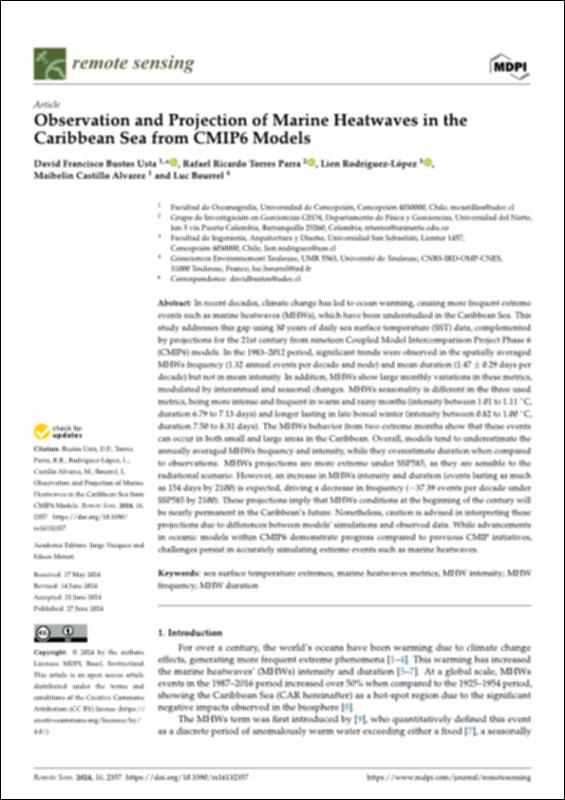- Inicio
- >
- Institucional
- >
- Acceso Abierto USS
- >
- Ver ítem
Descubre información por...
Buscar documentos por...

Temporalmente, el archivo digital asociado a esta publicación, no se encuentra disponible. Para más información escribir a [email protected]
Este documento se encuentra disponible en su fuente de origen, si desea acceder al texto completo, puedes hacerlo a continuación:
Observation and Projection of Marine Heatwaves in the Caribbean Sea from CMIP6 Models
|
Autor(es)
Rodríguez López, Lien; Bustos Usta, David Francisco; Torres Parra, Rafael Ricardo; Castillo, Maibelin; Bourrel, Luc |
|
ISSN:
2072-4292 |
|
Idioma:
eng |
|
Fecha:
2024-06-27 |
|
Tipo:
Artículo |
|
Revista:
Remote Sensing |
|
Datos de la publicación:
vol. 16 Issue: no. 13 Pages: |
|
DOI:
10.3390/rs16132357 |
|
Descripción:
Publisher Copyright: © 2024 by the authors. |
|
Resumen:
In recent decades, climate change has led to ocean warming, causing more frequent extreme events such as marine heatwaves (MHWs), which have been understudied in the Caribbean Sea. This study addresses this gap using 30 years of daily sea surface temperature (SST) data, complemented by projections for the 21st century from nineteen Coupled Model Intercomparison Project Phase 6 (CMIP6) models. In the 1983–2012 period, significant trends were observed in the spatially averaged MHWs frequency (1.32 annual events per decade and node) and mean duration (1.47 ± 0.29 days per decade) but not in mean intensity. In addition, MHWs show large monthly variations in these metrics, modulated by interannual and seasonal changes. MHWs seasonality is different in the three used metrics, being more intense and frequent in warm and rainy months (intensity between 1.01 to 1.11 °C, duration 6.79 to 7.13 days) and longer lasting in late boreal winter (intensity between 0.82 to 1.00 °C, duration 7.50 to 8.31 days). The MHWs behavior from two extreme months show that these events can occur in both small and large areas in the Caribbean. Overall, models tend to underestimate the annually averaged MHWs frequency and intensity, while they overestimate duration when compared to observations. MHWs projections are more extreme under SSP585, as they are sensible to the radiational scenario. However, an increase in MHWs intensity and duration (events lasting as much as 154 days by 2100) is expected, driving a decrease in frequency (–37.39 events per decade under SSP585 by 2100). These projections imply that MHWs conditions at the beginning of the century will be nearly permanent in the Caribbean’s future. Nonetheless, caution is advised in interpreting these projections due to differences between models’ simulations and observed data. While advancements in oceanic models within CMIP6 demonstrate progress compared to previous CMIP initiatives, challenges persist in accurately simulating extreme events such as marine heatwaves. |
Este ítem aparece en la(s) siguiente(s) colección(ones)
-
Acceso Abierto USS [2233]
Buscar
Listar
-
Todo el Repositorio
-
Esta colección
Mi cuenta
Acerca de
El Repositorio Institucional de la Universidad San Sebastián reúne los trabajos académicos y de investigación elaborados por la comunidad universitaria. Contribuye a la visibilidad y difusión, para ser consultados a través de acceso abierto por toda la comunidad nacional e internacional.
El objetivo del Repositorio es almacenar, conservar y entregar en formato electrónico, los resultados del quehacer institucional, permitiendo mayor visibilidad y difusión por medio del acceso abierto y gratuito.


